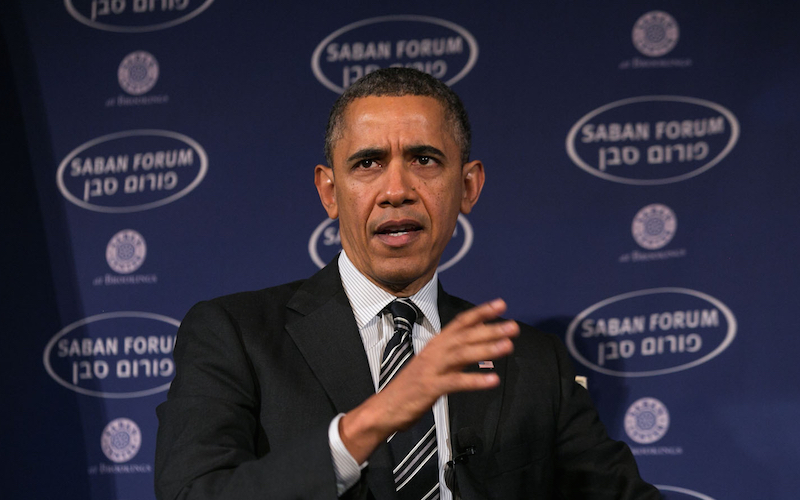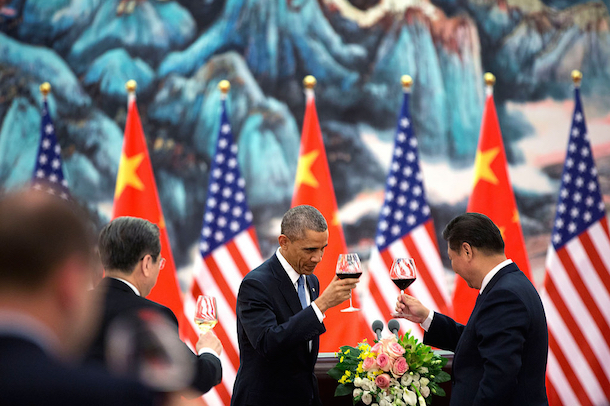
Will Obama’s Pivot to Asia Survive Beyond 2016?
From practically the moment Barack Obama announced he would “rebalance” U.S. foreign policy to focus on the Asia-Pacific, global events have conspired to keep America’s focus elsewhere. The Arab Spring, the Syrian civil war, the conflicts in Ukraine, the European debt and refugee crises, and the now-transnational threat posed by ISIS have all managed to keep Asian issues off American front pages. The most recent example of this was the much-awaited Trans-Pacific Partnership (TPP), the full text of which was released by the White House on November 6. Just one week later, terrorist attacks in Paris made sure a free trade agreement (even one that would impact 40% of the global economy) would be the furthest thing from anyone’s mind.
While Asia may get less than its fair share of attention in American foreign policy circles, the Obama administration has gamely kept up its efforts to cement regional partnerships and manage China’s rise. The U.S. president traveled both to Manila for APEC and to Kuala Lumpur for the ASEAN summit in November, using them to address issues such as the TPP and China’s provocative island-building in the South China Sea. He also met with key U.S. partners such as the Philippines’ Benigno S. Aquino III and Malaysia’s Datuk Seri Najib Razak, whose countries join Japan, South Korea, Indonesia, and Vietnam (among others) as key nodes in the regional network of allies the United States has spent years putting together.
Beyond their nervousness over China’s motives, what brings these Pacific nations together is their (collective) role as a key engine of global growth.
Japan, Australia, South Korea, and Indonesia already rank among the world’s largest economies. The ten-member ASEAN community includes Indonesia as well as steadily expanding economies in the Philippines and Malaysia. ASEAN saw its collective GDP grow by 4.6% to $2.57 trillion USD in 2014; by comparison, the Eurozone grew by only 0.8%.
The GDP of Indonesia has averaged robust 5.8% average growth in the years since the financial crisis, with PricewaterhouseCoopers predicting Indonesia’s $896 billion GDP economy could become the world’s fourth largest by 2050. Malaysia’s Economic Transformation Programme, meanwhile, is on track to make Malaysia a high-income country by the year 2020. In the six years since Najib took office, the national GDP has grown from $202 billion to nearly $327 billion. Per capita GDP has risen two-thirds (from $7,300 to over $10,900), while the government’s development efforts have created 1.8 million additional jobs and have nearly eradicated poverty by setting up an ambitious minimum wage floor.
Obama and U.S. Trade Representative Michael Froman, who spearheaded the American role in negotiating the TPP, understand the importance of deepening trade ties with these rapidly growing economies. By drafting a free trade agreement that includes environmental protections, guarantees for independent labor organizations, and intellectual property laws, the United States is trying to build a trade system which enshrines the types of rules Chinese officials tend to disregard. With Obama trying to get the agreement through the U.S. Congress before he leaves office in January 2017, the fate of a major part of his legacy (and of America’s Asia-Pacific policy) remains in doubt. In any event, continuing the pivot to Asia will ultimately be a decision for Obama’s successor to make.

In running for the Democratic nomination, both major candidates (former Secretary of State Hillary Clinton and Senator Bernie Sanders) have come out against the TPP. Sanders, in line with his populist working-class platform, has long been one of the most vocal opponents of Obama’s push for free trade. Clinton, on the other hand, attempted to make up lost ground among labor groups by breaking with Obama on the deal back in October. Clinton’s decision to oppose the landmark agreement exposed her to accusations of flip-flopping, given her own leading role in formulating current U.S. foreign policy. She herself helped coin the “pivot” phrase in a 2011 Foreign Policy piece, a message in which she argued the TPP could “serve as a benchmark for future agreements — and grow to serve as a platform for broader regional interaction and eventually a free trade area of the Asia-Pacific.” So far as the Republicans go, it’s hard to say what tack the nominee will take when both frontrunners (Donald Trump and Ben Carson) have no actual foreign policy experience between them.
As the nominations on both sides play out, any candidate who wants to present a realistic foreign policy will need to explain how they plan to keep the critically important ASEAN countries on Washington’s radar.
One anecdote from Obama’s November visit to Malaysia may prove especially telling. As both Najib and Obama noted after a bilateral meeting, Obama has been the first U.S. president to visit Malaysia in 50 years. This may come as a surprise, as the country offers a lucrative market for American companies. Like Singapore, New Zealand, South Korea, China, and Australia, the World Bank ranks Malaysia as one of the world’s easiest places to do business. Even more than some of its neighbors and ASEAN partners, Najib’s Malaysia also offers millions of potential customers with growing personal income: in terms of purchasing-power parity, per capita GDP in Malaysia now stands at $25,000. Nevertheless, the U.S. president visiting a major regional and economic partner is somehow still historic. Obama’s own experiences growing up in Indonesia may inform his outreach to southeast Asia, but will the next president build on Obama’s moves and take a more systematic approach to the region?
As then-Secretary of State Clinton wrote in 2011: “Beyond our borders, people are also wondering about America’s intentions — our willingness to remain engaged and to lead. In Asia, they ask whether we are really there to stay, whether we are likely to be distracted again by events elsewhere, whether we can make — and keep — credible economic and strategic commitments, and whether we can back those commitments with action. The answer is: We can, and we will.” Unfortunately, the last four years seem to have proven her wrong. America’s partners in the Asia-Pacific will have to hope the next president can focus in a way Obama was never entirely able to do.

